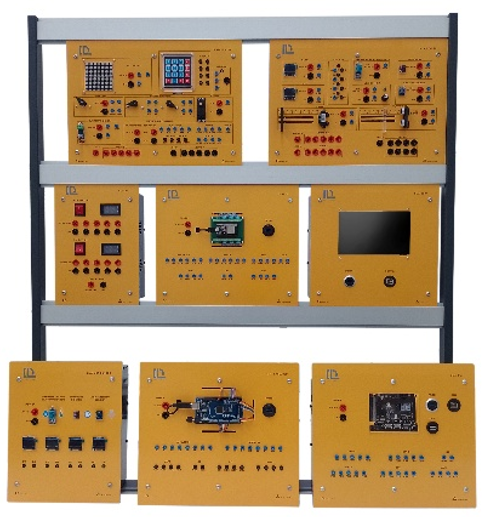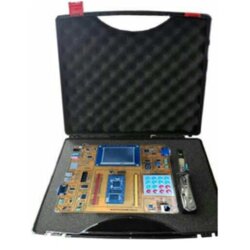Laboratory For The Development Of Artificial Intelligence For Colleges (DL AI-BASE)


PL-416415
This didactic laboratory DL AI-BASE is an introductory platform designed for technical and vocational education. It offers a practical and accessible approach to the fundamentals of Artificial Intelligence and the Internet of Things. With integrated hardware and software, students can explore real-life scenarios while developing basic skills in AI-based problem solving. The laboratory serves as a solid foundation for future studies in emerging technologies. The laboratory DL AI-BASE is mainly composed of a system with hardware modules with the support of a Server on which all the software related to AI field is installed. Three students can work on it performing all the experiments and the proposed training objectives with the help of the provided software’s as listed at the end of this catalogue in “SOFTWARE APPLICATIONS” & “TRAINING OBJECTIVES”. Even the three students who work with the HW need their own PC. This lab also allows to increase the student’s number, up to 17 (becoming 20 students total), to work on it at the same time (with access to the Server from their own PCs) by providing a single license each. This additional license (when and if needed) has the following code DL AI-BASESW. Please refer to other suggested configurations at the end of this catalogue.
PEDAGOGICAL APPROACH
In the didactic laboratory for the development of Artificial Intelligence solutions, the challenge-based learning (CBL) approach focuses on providing students with practical, real-world challenges that allow them to apply theoretical knowledge in specific situations. Rather than simply presenting information passively, this approach engages students in solving problems and creating innovative solutions. Students are faced with challenges that simulate real-life and industry problems, such as process optimization, anomaly detection or efficiency improvement. Using the hardware and software available in the lab, as well as artificial intelligence tools, students work in teams to develop practical solutions that address these challenges.
MAIN CHARACTERISTICS
- Multidisciplinary: Useful for the study of software development, artificial intelligence.
- Economic: By involving several disciplines, the cost of the product can be divided among different departments.
- Open: Provides the architecture to implement standard and new solutions, allowing the use of the product in professional and research activities.
- State-of-the-art: The product provides a descriptive view of software architecture for development using artificial intelligence.
MAIN DIDACTIC CONCEPTS
- Embedded systems programming.
- Basic concepts of AI, Machine Learning (ML).
- Sensors and actuators as data sources.
- Data processing and analysis.
- AI programming and tools.
- Industrial applications.
- IoT systems design.
SIMULATED INDUSTRIAL CHALLENGES
- Lighting management.
- Quality control.
- Process automation, Detection.
- Predictive maintenance.
- Condition monitoring.
- Optimization and IoT sensorics.
WHO IS IT FOR?
Schools and colleges (to validate theory and test concepts):
- Programming and Algorithmic Logic.
- Electronics and Embedded Systems.
- Computer Science.
- Artificial Intelligence and Machine Learning.
- Smart Systems and IoT.
ELEMENTS THAT COMPOSE IT
SENSING MODULE - IT ALLOWS YOU TO:
- Collect essential data to train AI models.
- Provide real-time information for decision-making.
- Simulate real-world conditions to solve practical problems.
- Connect the physical world with AI applications.
- Facilitate experimentation with different types of data.
- Allow measuring, monitoring, and controlling environmental variables.
- Help understand the impact of AI on physical systems.
- Drive hardware and software integration in educational projects.
- Promote active learning through direct manipulation.
- Encourage innovation by exploring new AI applications.
ACTUATOR MODULE - IT ALLOWS YOU TO:
- Transform AI decisions into physical actions.
- Enable tangible interaction with the environment.
- Demonstrate the applicability of AI in real systems.
- Facilitate validation of AI predictions and models.
- Teach how to automate processes using AI.
- Simulate practical solutions for industrial problems.
- Convert processed data into useful responses.
- Integrate theoretical learning with visible results.
- Foster creativity in designing intelligent systems.
- Promote understanding of AI’s impact on automation.
POWER SUPPLY MODULE
- Universal voltage input: Compatible with 110 - 240Vac.
- Regulated outputs: Provides 5V and 3.3Vdc simultaneously.
- Current capacity: Supports up to 2A per outp ut.
- Overload protection: Prevents damage from excess current or short circuits.
- Compact design: Easy integration into prototypes or mounted systems.
- Standard connectors: Screw terminals and pins for easy connections.
- LED indicators: Shows power status in real time.
- Energy efficiency: Reduces energy loss during conversion.
- Compatibility: Ideal for powering microcontrollers like Arduino, NodeMCU, and sensors.
- Easy mounting: Can be fixed to surfaces or educational racks.
EMBEDDED PROGRAMMING MODULE - (ARDUINO MEGA)
- Basic Level – Fundamentals of Embedded Programming:
- Introduction to embedded systems and their applications.
- Configuration of digital inputs and outputs.
- Timing and control of simple events.
- Reading analog signals.
- Generation of pulse-width modulated (PWM) outputs.
- Use of conditional structures and control loops.
- Handling variables, constants, and data types.
- Introduction to using the serial monitor for debugging.
- Intermediate Level – Sensing and Basic Control:
- Reading physical environment variables through sensors.
- Implementation of conditional logic based on analog and digital inputs.
- Use of control structures to automate processes.
- Generation of visual, sound, or mechanical responses to events.
- Display of local data (screens or indicators).
- Use of interrupts for efficient event handling.
- Introduction to temporary data storage.
- Design of programs with basic proportional control.
- Advanced Level:
- Implementation of serial communication between devices.
- Transmission and reception of data for monitoring or remote control.
- Design of autonomous systems with decision-making.
- Reading and interpreting industrial signals (0 ÷ 10 V, 4 ÷ 20 mA).
- Design of control sequences for automated processes.
- Modularization of code and reuse of functions.
- Process control using timers and logical counters.
- Integration of multiple subsystems into a functional project.
- Intermediate Level – Sensing and Basic Control:
- Reading physical environment variables through sensors.
- Implementation of conditional logic based on analog and digital inputs.
- Use of control structures to automate processes.
- Generation of visual, sound, or mechanical responses to events.
- Display of local data (screens or indicators).
- Use of interrupts for efficient event handling.
- Introduction to temporary data storage.
- Design of programs with basic proportional control.
- Advanced Level:
- Implementation of serial communication between devices.
- Transmission and reception of data for monitoring or remote control.
- Design of autonomous systems with decision-making.
- Reading and interpreting industrial signals (0 ÷ 10 V, 4 ÷ 20 mA).
- Design of control sequences for automated processes.
- Modularization of code and reuse of functions.
- Process control using timers and logical counters.
- Integration of multiple subsystems into a functional project.
INTERNET OF THINGS (IOT) MODULE - (NodeMCU)
- Basic Level – Fundamentals of IoT:
- Introduction to the Internet of Things concept.
- General architecture of an IoT system.
- Communication between local devices.
- Configuration of wireless networks.
- Sending and receiving data via Wi-Fi.
- Publishing data to local interfaces (serial monitor or console).
- Use of basic protocols for data transmission (HTTP).
- Programming periodic routines for data capture and sending.
- Intermediate Level – Interaction with Remote Services:
- Client-server structure in IoT.
- Sending data to remote databases.
- Displaying variables on web interfaces.
- Introduction to lightweight messaging protocols (Socket).
- Use of graphical interfaces for real-time monitoring.
- Storage and retrieval of historical records.
- Configuration of dashboards for remote visualization.
- Error handling and automatic network reconnection.
- Advanced Level – Distributed Automation and Decision Making:
- Implementation of cloud logic and remote control.
- Receiving commands from web or mobile interfaces.
- Event-driven programming for real-time response.
- Security in IoT systems (validation, basic encryption).
- Synchronization of states between devices.
- Development of integrative applications: monitoring, alert, automatic response.
AI DEVELOPMENT MODULE - (Jetson NANO NVIDIA)
- Basic Level – Fundamentals of AI and Data Science:
- Difference between symbolic AI and machine learning.
- Introduction to supervised and unsupervised learning.
- Python fundamentals applied to AI (syntax, structures, libraries).
- Data representation: vectors, matrices, and normalization.
- Reading data from sensors or local files.
- Data visualization and exploratory data analysis (EDA).
- Building simple classification models with labelled data.
- Intermediate Level – Applied Machine Learning:
- Architecture of basic artificial neural networks.
- Preparation of custom datasets (physical sensors, CSV, images).
- Training, validation, and testing of models.
- Pattern detection in physical data (temperature, humidity, light, pressure).
- Application of regression and classification models with multiple inputs
- Introduction to specialized libraries: TensorFlow, scikit-learn, Keras.
- Exporting and inference of trained models on embedded systems.
- Logging and analyzing prediction results for decision-making.
- Advanced Level – Real-time AI and Physical Integration:
- Real-time image processing and computer vision.
- Object detection and classification using pre-trained models.
- Integration of AI with physical data acquisition systems.
- Model optimization for fast inference on embedded systems.
- Implementation of intelligent alerts for anomalous events.
- Design of autonomous AI-based solutions (quality, safety, maintenance).
- Intelligent decision-making in physical environments (IoT + AI).
- System performance evaluation: metrics, errors, accuracy, and continuous improvement.
SOFTWARE APPLICATIONS
INCLUDED SOFTWARE
- MySQL Database
- Logging and querying of sensed variables, events, and AI decisions.
- Database Cloning
- Students working in parallel.
- Provides knowledge of database administration.
- Block-based Programming
- Control and programming in a block-based environment to acquire knowledge in programming.
- Web Services
- Integration with external systems, dashboards, or remote AI.
MAIN BASIC CONFIGURATION (20 students)*
- 1 x DL AI-BASE – AI Main configuration (Hardware system, Server, Software’s, and Applications) (for 3 students).
- 17 x DL AI- BASESW. (for 17 students)
EXAMPLES FOR OTHER CONFIGURATIONS*
If the laboratory includes less than 20 students (i.e. 15 students), it will be necessary to have:
- 1 x DL AI- BASE. (for 3 students)
- 12 x DL AI- BASESW. (for 12 students)
If it includes 30 students, it will be necessary to have:
- 2 x DL AI- BASE. (for 6 students)
- 24 x DL AI- BASESW. (for 24 students)
If it includes 40 students, it will be necessary to have:
- 2 x DL AI- BASE. (for 6 students)
- 34 x DL AI- BASESW. (for 34 students)
If it includes 50 students, it will be necessary to have:
- 3 x DL AI- BASE. (for 9 students)
- 41 x DL AI- BASESW. (for 41 students)
If it includes 55 students, it will be necessary to have:
- 3 x DL AI- BASE. (for 9 students)
- 46 x DL AI- BASESW. (for 46 students)
If it includes 60 students, it will be necessary to have:
- 3 x DL AI- BASE. (for 9 students)
- 51 x DL AI- BASESW. (for 51 students)
*: even the three students who work with the HW need their own PC, and DL AI-BASESW is a single license for the expansion of the basic hardware configuration.
What is this?
These percentage scores are an average of 0 user reviews. To get more into detail, see each review and comments as per below
If you have used this product, support the community by submitting your review



